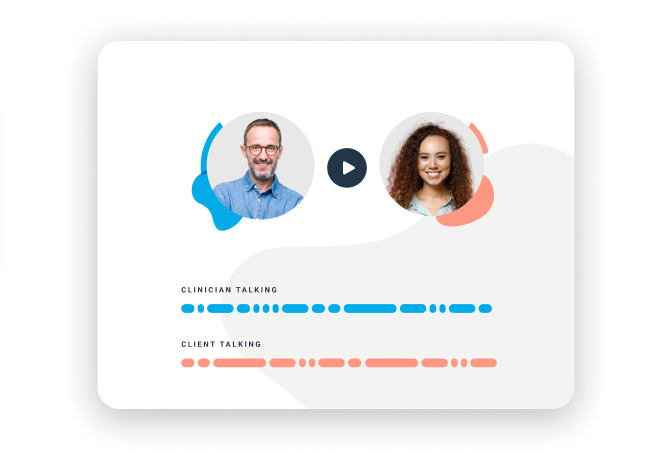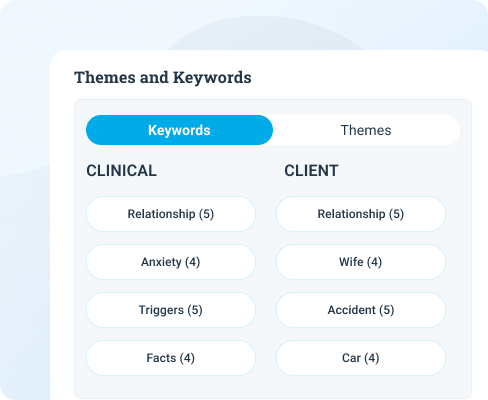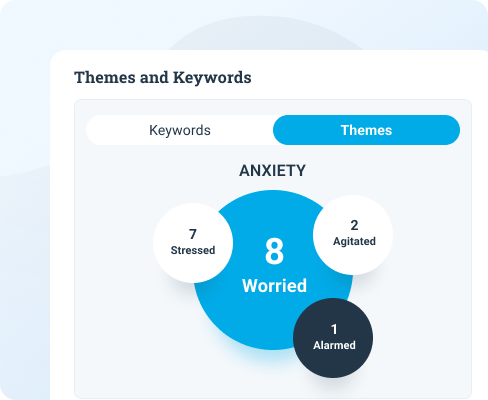Supervision has always been a foundational part of becoming a mental health professional. It’s how new therapists grow: they need detailed feedback, guided reflection, and a nuanced understanding of therapeutic interactions that they can only get through insight from a seasoned practitioner.
For many years, clinical supervision was conducted in one of two ways:
- Transcribing every session by hand so that supervisors could provide a comprehensive review (at the cost of countless hours).
- Relying entirely on the supervisee’s memory of the session (a much faster, though less reliable, method).
Eventually, technological advancement brought us recording devices that allowed supervisors to access more detailed information—but listening to a full session recording takes a lot of time. And with most supervisors mentoring multiple novice clinicians simultaneously, they just don’t have the capacity to review clinical work to that degree.
So, what’s the solution?
According to Donna Sheperis, PhD, Director of Palo Alto University’s eClinic, AI can bridge the gap between supervision best practices and practical limitations.
“We started asking, what are the other best practice options—and what is the research telling us?” Sheperis said during a recent interview with Eleos. “And we really started looking at best practices beyond the technology already made available to us.”
The PAU team’s exploration of emerging technologies led them to Eleos Health’s AI platform.
“We were able to start using this supervision software that lets us see [a session summary] immediately after a session because of the software’s approach to transcription and video technology,” Sheperis said. “They could also see keywords and a thematic analysis.”
Two new research papers—both offering guidance to other organizations interested in using AI to supervise novice therapists—grew out of PAU’s experience with Eleos.
Unpacking AI’s Role in Clinical Supervision
The two new studies, both focused on how AI-driven tools can facilitate the supervisory process, are:
- “Integrating Artificial Intelligence in a Telemental Health Clinic”
- “Using AI-Supported Supervision in a University Telemental Health Training Clinic”
Paper 1: Integrating Artificial Intelligence in a Telemental Health Clinic
This study examines how Eleos Health’s AI platform has been integrated into the PAU eClinic and explores the many ways the technology is revolutionizing clinical supervision and advancing therapeutic proficiency.
As noted in the paper, here are the key ways Eleos has streamlined and improved clinical supervision at PAU:
- Automating Transcription and Analysis: By automating transcription, the AI platform provides immediate access to detailed session content. Not only does this save time, but it also keeps supervisees from getting bogged down with administrative tasks.
- Enhancing Feedback Quality: The AI analyzes therapy sessions thematically and identifies key moments, enabling supervisors to give more precise, insightful feedback. This leads to a deeper, more meaningful dialogue between supervisors and their supervisees, because they can focus on the most important parts of each session.
- Supporting Evidence-Based Practice: The platform also highlights when and how evidence-based practices (EBPs) are applied during sessions. This real-time feedback mechanism encourages therapists to leverage EBPs more confidently and competently.
In addition to examining the value of AI in provider supervision, the study discusses how AI-driven tools make clinical learning environments more dynamic. When measurement-based care mechanisms are integrated into the AI platform, therapists get immediate feedback on client outcomes, so they can tailor their approach in a more timely and precise manner.
Data on metrics like interventions used and talk-versus-listen time provide developing clinicians with instant insights into their performance—even without the participation of a supervisor. This allows therapists in training to get more out of their supervision sessions—and hold more informed discussions about their professional challenges and areas for growth.
Ultimately, the technology enhances the quality of therapy and helps therapists sharpen the skills they need to excel. And it also helps both supervisee and supervisor achieve greater mastery of their respective roles.
Paper 2: Using AI-Supported Supervision in a University Telemental Health Training Clinic
This peer-reviwed study builds on the insights from the first paper, exploring the specific benefits of using AI for supervision of novice therapists. These benefits include improvements to the efficiency and educational value of supervision.
The authors note the following benefits of leveraging an AI tool as part of the supervision process:
- Facilitating Data-Driven Feedback: The AI platform enables a more objective approach to supervision, where supervisors can review key parts of a session without sifting through the whole thing manually. That way, they can consistently provide more focused, actionable feedback.
- Improving Supervisory Efficiency: When supervisors need less time to review each session, they can mentor more trainees and spend more time with each one—all without sacrificing the quality of their supervision. In fact, AI actually amplifies the impact of supervision by allowing for more frequent and focused feedback cycles.
- Enhancing the Training Experience: Trainees benefit from an enriched training experience where they receive timely, detailed feedback on their clinical skills and therapeutic approaches. The immediacy and depth of this feedback accelerates their growth and confidence as emerging therapists.
Addressing Challenges and Getting Buy-in
While the benefits of integrating AI into the supervisory process are clear, the transition to AI-supported supervision wasn’t entirely seamless for the team at PAU. This excerpt from the paper “Using AI-Supported Supervision in a University Telemental Health Training Clinic” details some of the barriers eClinic leaders encountered:
“Implementation challenges were naturally part of the process. In addition to the learning curve of adjusting to the new system, we had to address the anxiety an AI supervision platform brought to the clinicians and some supervisors. After thoroughly consenting all clients, and thoroughly training all clinicians and supervisors, we were able to address subsequent concerns. Clinicians initially were worried that the platform, with its session documentation and metrics, would somehow be weaponized against them. They worried that the data would only point to what they were doing wrong, rather than support what they were doing well. Supervisors had their own concerns, primarily that somehow their input would be lessened by the presence of machine learning information. Despite embracing telemental health and technology in general, dealing with these specific, personal concerns took some time and effort by the university clinic director and advisors.”
These initial apprehensions from clinicians and supervisors revealed a critical aspect of driving a successful AI adoption: fostering trust. Concerns that the platform’s data collection and analysis could be used punitively rather than supportively point to a broader issue of how AI tools might be perceived within clinical settings.
Sheperis noted that addressing these concerns head-on was critical. “Clinicians were worried that they would get in trouble,” she shared.
To dispel this misconception that AI summaries would focus on therapists’ shortcomings, program leaders put extra effort into educating them about the technology, its purpose, and its capabilities.
To start, the team collected the necessary consent from all clients (note that consent is only required when sessions are recorded). Then, they trained all clinicians and supervisors on the platform, emphasizing its supportive role. Sheperis’s approach to demystifying AI was rooted in straightforward communication: explaining what the platform was intended for and emphasizing that it wasn’t about surveillance—it was about improving care.
“We just laid it out on the table: ‘This is what it’s for. This is what it’s not for. This is how we use it,’” Sheperis said.
This open forum provided a space for clinicians and supervisors to voice their fears, get answers to their questions, and discover the potential benefits of AI in their work.
That proved to be a turning point. As apprehension faded, acceptance and even enthusiasm for the role of AI in clinical supervision grew. As for the resistance, Sheperis recounted that she “never heard it again.”
Reaping the Benefits of AI in Clinical Supervision: A Therapy Educator’s Take
Thanks to her experience with Eleos at PAU’s eClinic, Sheperis said AI has become an integral part of her supervisory process.
“As a supervisor, I spend less time watching entire videos because Eleos gives me a snapshot,” Sheperis said. “I know where to go and listen to the most important parts. If I have a question, I can quickly find [the relevant part] in the session transcript and then find it in the video. That lets me use my time better.”
Here’s a breakdown of some of the Eleos platform’s key supervision features, along with Sheperis’s perspective on their role in enhancing clinical supervision.
Real-Time Thematic Analysis
Offers immediate insight into session themes, enabling supervisors to understand the core issues discussed without having to review hours of recordings.
Intervention Tracking
Identifies the therapeutic strategies employed during sessions, which is crucial for clinics focused on evidence-based care. This allows supervisors to monitor and guide the use of specific interventions effectively.
Talk Time Analytics
Provides valuable feedback on the balance of dialogue within therapy sessions, helping new therapists learn when to interject and guide a productive session flow.
Data-Informed Coaching
Enables a targeted supervision strategy, allowing for a focused review of the specific interventions, themes, or exchanges that are most relevant to the provider’s growth.
Step-by-Step Guide for Integrating AI into Therapy Supervision
Here’s a quick breakdown of how Sheperis integrates these AI features into her supervision workflow. (Watch the clip below for her full explanation, or skim the highlights as quoted underneath the video.)
Step 1: Analyze Balance of Talk Time
| “The first thing I do is go to the previous week’s sessions for my supervisees’ clients and check the fidelity talk time,” Sheperis said. “New professionals are often hesitant to interject. They view interjecting as interrupting. They will let a client continue speaking when they should pause at a certain point—and they will have missed an opportunity. For that, I look for ‘big bubbles’—bubbles are the length. So even if the analytics say that the time spent talking is 50/50, I want to see if one person went on for too long.” |

Step 2: Assess Usage of Evidence-Based Techniques
| “From there, I go to interventions used, which are ticked below the talk time [in Eleos],” Sheperis continued. “If I’m interested—if there’s goal-setting or validation—I’ll click on it, look at the transcript, and maybe even watch that snippet of video.” |
Step 3: Review Thematic Analysis
| “Then I’ll go down to themes, check keywords, look at bits of the transcript, and watch key bits of the video,” Sheperis explained. “I’m able to very quickly know what my clinical supervisees dealt with that week with their patients and understand what we need to talk about in supervision.” |
 |  |
Step 4: Talk About It in Supervision
| “I work entirely remotely, so I am supervising using multiple screens—one with my supervisees’ faces [on a video call], and one with their Eleos dashboard,” Sheperis said. “If I need to screen-share, I do, but they usually know exactly what I am referring to when I say, ‘Did you notice in that last session with so-and-so that there was…’ or, ‘When I look across all of your sessions I tend to see…Is that how you see it?’” |
By following Sheperis’s approach, supervisors can maximize the benefits of AI in clinical supervision, providing a richer, more focused, and more effective learning experience for their supervisees—not to mention a more efficient use of supervisory time!
And the impact of more contextual, meaningful supervision extends beyond care improvement. As Shiri Sadeh-Sharvit, PhD, Eleos Health’s Chief Clinical Officer and a practicing clinical psychologist, notes, it can also be a powerful driver of provider retention.
“Across the behavioral health field, recruiting and retaining seasoned clinical supervisors has been a persistent struggle,” she said. “AI offers a promising solution. AI-powered training can personalize the learning experience for novice therapists, focusing on their individual strengths and weaknesses. This fosters a more skilled and motivated workforce, ultimately leading to a more fulfilling experience for both therapists and their supervisors. Our experience integrating Eleos within the eClinic and numerous other behavioral health programs has taught us that—as with any new technology—it’s important to effectively manage the introduction of AI into the workplace. Supervisors remain crucial in guiding therapists to leverage AI as a powerful tool, while simultaneously honing essential, softer skills such as empathy, reflective listening, and recognition of nuances.”
The integration of Eleos Health’s AI into clinical supervision at Palo Alto University’s eClinic signifies an important step forward in clinical education. This blend of technology and traditional mentorship enriches the training process, better preparing new therapists for real-life practice.

